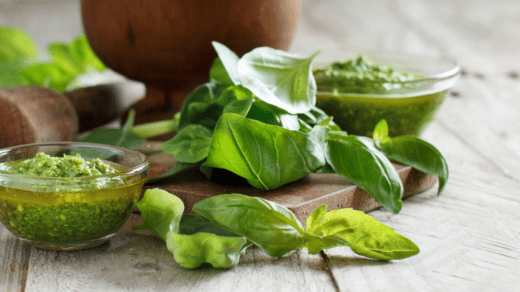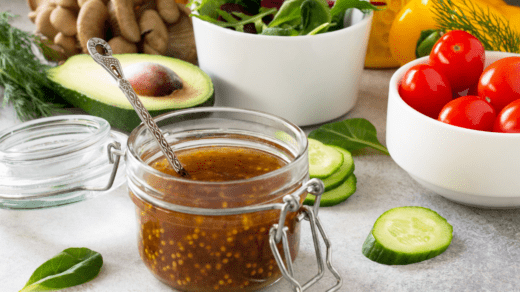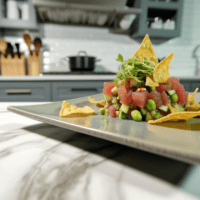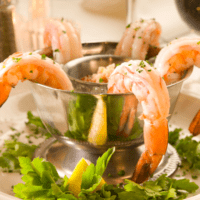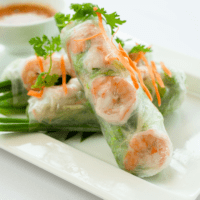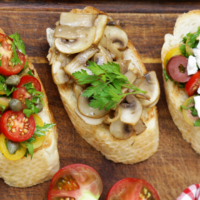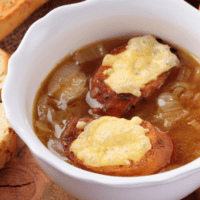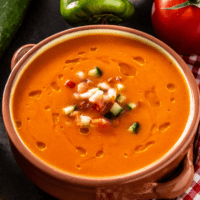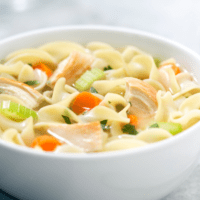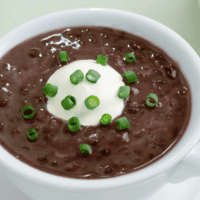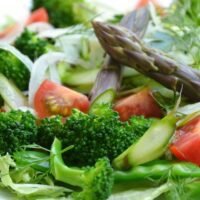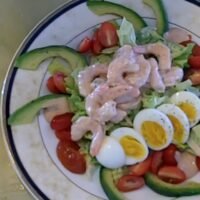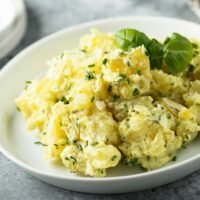Hey There! Some links on this page are affiliate links, which means that as an Amazon Associate, I may earn a small commission at no extra cost to you. I greatly appreciate your support! Learn more on my Affiliate Disclosure page.
Let’s explore the world of buttermilk and unravel its mysteries. If you’ve ever wondered what is buttermilk and how it’s used in cooking, you’ve come to the right place. Whether you’re a seasoned chef or an aspiring home cook, understanding the ins and outs of this versatile ingredient can elevate your culinary creations to new heights.
Buttermilk, a staple in kitchens for centuries, has its origins in the days when butter was churned at home. This byproduct of the butter-making process, with its tangy flavor and myriad uses in cooking, quickly gained popularity. Beyond being a key ingredient in baking recipes like biscuits and pancakes, buttermilk’s acidity also makes it a versatile marinade for tenderizing meat and adding a depth of flavor to dishes.
Buttermilk’s versatility extends beyond sweet treats to equally noteworthy savory applications. From creamy dressings and marinades to fluffy fried chicken coatings, buttermilk’s tangy profile can elevate classic comfort foods and gourmet dishes. In addition to its culinary uses, buttermilk has also found favor in skincare routines for its gentle exfoliating properties and ability to soothe irritated skin.
Key Takeaways:
- Buttermilk is a versatile ingredient used in a variety of recipes, including biscuits, fried chicken, and salad dressings.
- The most common type of buttermilk, cultured buttermilk, is made by fermenting milk with active bacteria cultures.
- Buttermilk tenderizes meats, adds moisture to baking, and imparts a tangy flavor to dressings and sauces.
- It offers nutritional benefits, such as being low in fat and calories, high in protein, and easily digestible for lactose-intolerant individuals.
- If you don’t have buttermilk on hand, you can easily make homemade substitutes, including acid-milk mixtures and full-fat yogurt.
The Culinary Uses of Buttermilk
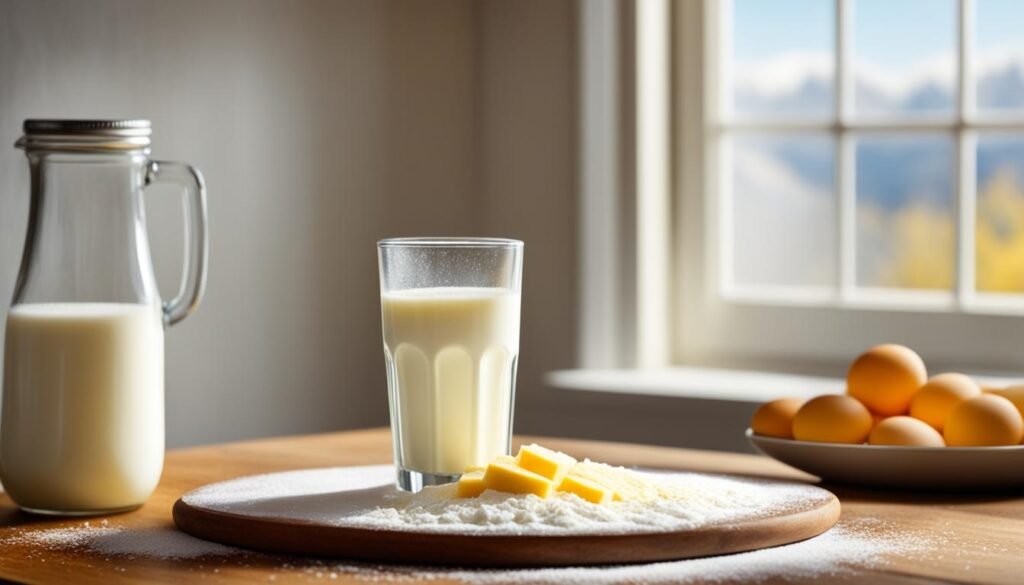
Buttermilk is a versatile ingredient that can enhance the flavor and texture of various dishes. Its tangy taste and acidic properties make it a fantastic tenderizer for meats. As a marinade, buttermilk helps break down chicken, steak, or pork proteins, resulting in juicier and more tender cuts.
In the world of baking, buttermilk plays a crucial role in creating moist and tender treats. It adds richness and tanginess to pancakes, waffles, biscuits, and cakes. The acidity in buttermilk reacts with leavening agents like baking soda or baking powder, resulting in light and fluffy results.
In addition to its baking prowess, buttermilk is a key ingredient in salad dressings, specifically the beloved buttermilk ranch. The creamy and tangy nature of buttermilk brings a delightful twist to dressings, adding depth and complexity to salads.
Buttermilk can also be incorporated into soups and sauces to contribute a creamy and tangy element. It adds a velvety texture and a pleasant zing to these savory dishes, elevating their overall flavor profiles.
Whether you’re grilling, baking, or sautéing, buttermilk is a versatile culinary companion that adds a unique touch to your recipes.
The Benefits of Buttermilk

Buttermilk is not just a delicious and versatile kitchen ingredient; it also offers a range of health benefits. From being low in fat and calories to providing important nutrients, buttermilk can be a valuable addition to your diet.
Nutritional Benefits
When it comes to nutrition, buttermilk has several advantages over regular milk. Here are some key benefits:
- Low in fat and calories: Buttermilk contains less fat and calories compared to whole milk, making it a healthier option for those watching their weight or following a low-fat diet.
- Higher protein content: A cup of buttermilk typically contains more protein than regular milk, essential for muscle repair and growth.
- Good source of calcium: Calcium is crucial for maintaining strong bones and teeth, and buttermilk provides a significant amount of this vital mineral.
- Rich in vitamin B12: Vitamin B12 is necessary for the production of red blood cells and supports healthy brain function. Buttermilk is a natural source of this important vitamin.
- Contains potassium: Potassium is an electrolyte that helps maintain proper fluid balance in the body and supports heart health. Buttermilk contains potassium, contributing to its overall nutritional value.
Digestive Benefits
One of the unique advantages of buttermilk is its live cultures, similar to those found in yogurt. These cultures aid digestion and make buttermilk more easily digestible for individuals with lactose intolerance. The presence of beneficial bacteria also promotes a healthy gut by supporting the growth of beneficial intestinal flora.
“Buttermilk’s live cultures aid digestion and make it more easily digestible for individuals with lactose intolerance.”
The acidity of buttermilk further assists with digestion by acting as a natural digestive aid. It can help break down food more efficiently, promoting smoother digestion and reducing discomfort after meals.
Incorporating buttermilk into your diet can provide both nutritional and digestive benefits, making it a wise choice for those seeking a healthier and more digestive-friendly option.
Making Homemade Buttermilk Substitute
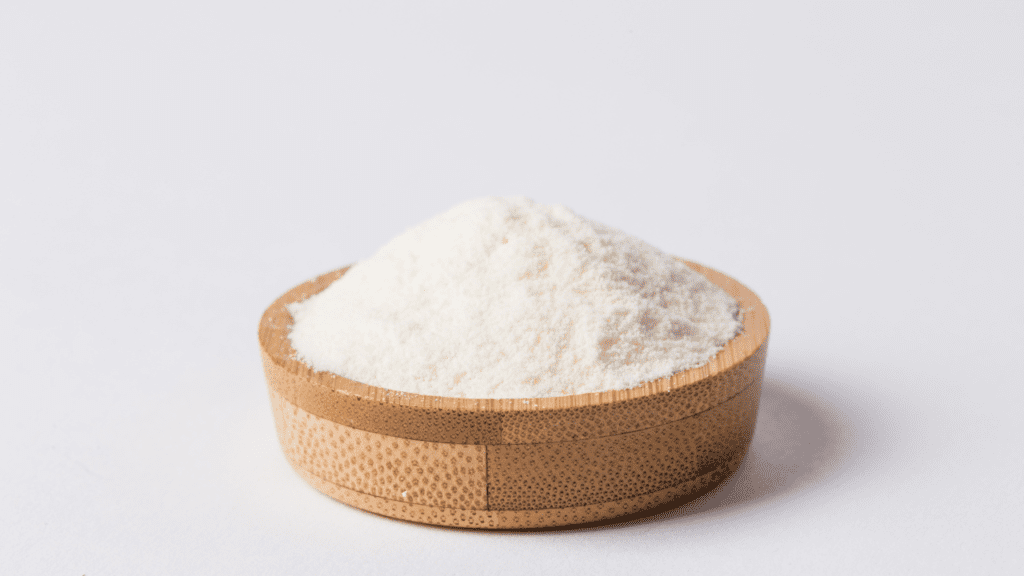
If you don’t have buttermilk on hand, you can make several easy substitutes at home.
- An Acidic Option: Mix lemon juice or white vinegar with milk.
- To make 1 cup of buttermilk, combine 1 tablespoon of lemon juice or vinegar with enough milk.
- Yogurt Substitute: Use full-fat yogurt as a 1-to-1 replacement for buttermilk.
- Greek yogurt can be thinned out with water to achieve a similar consistency.
- Buttermilk Powder: Purchase buttermilk powder and reconstitute it with water as needed. It is made from real buttermilk and provides an authentic flavor.
Experiment with these substitutions to find the one best suits your recipe and taste preferences.
“When you run out of buttermilk, don’t worry! There are simple homemade substitutes you can whip up in minutes.”
How to Make Buttermilk from Milk
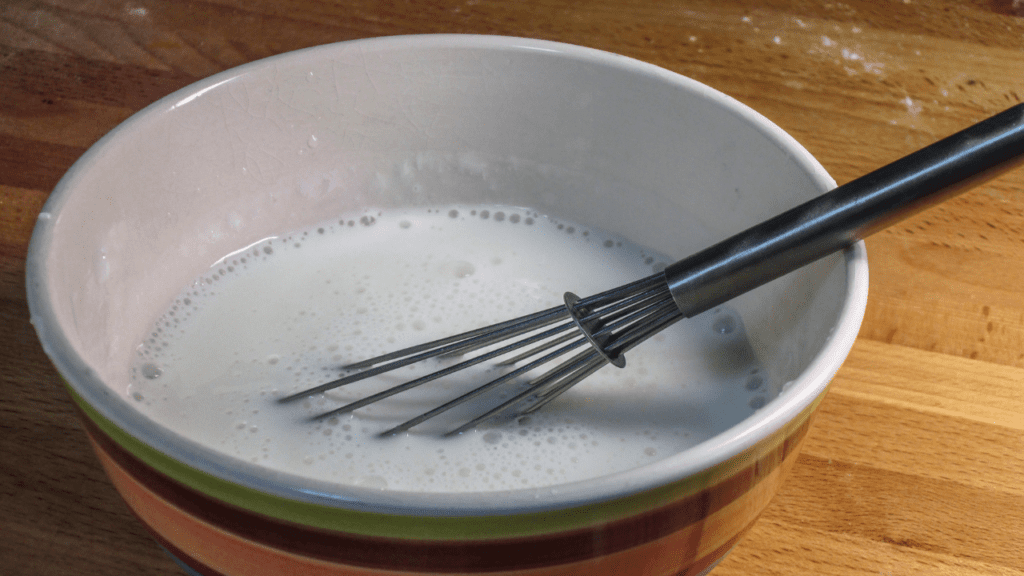
If you prefer to make your buttermilk from milk, it is a simple process that requires some time for fermentation. You can choose between two methods to create homemade buttermilk.
The first method involves using a buttermilk starter culture, which can be purchased from specialty stores or online. The second method is mixing store-bought buttermilk with milk.
Method 1: Buttermilk Starter Culture
In this method, you will need a buttermilk starter culture, which can be purchased from specialty stores or online. Follow these steps to make buttermilk:
- Pour 1 cup of milk into a clean, sterilized container.
- Add the recommended amount of buttermilk starter culture to the milk. The package instructions will specify the appropriate quantity.
- Stir the milk and culture mixture gently to combine.
- Cover the container with a clean cloth or plastic wrap.
- Place the container in a warm location, ideally between 70-77°F (21-25°C).
- Allow the mixture to ferment for 12 to 24 hours. The longer you let it ferment, the tangier the buttermilk will become.
Once the fermentation process is complete, your homemade buttermilk is ready to use in your favorite recipes.
Method 2: Mixing Store-Bought Buttermilk with Milk
If you have store-bought buttermilk, you can use it as a starter to make more buttermilk. Follow these steps:
- Mix 1/3 cup of store-bought buttermilk in a clean container with 1 cup of milk.
- Stir the mixture gently to combine.
- Cover the container with a clean cloth or plastic wrap.
- Place the container in a warm location, preferably between 70-77°F (21-25°C).
- Allow the mixture to ferment in a warm place until it thickens, usually within 12 to 24 hours.
Once the buttermilk has thickened, it can be used in various recipes or stored for future use.
Please note that homemade buttermilk may not have the same flavor profile as commercially produced buttermilk, but it will still add the desired tanginess and creaminess to your culinary creations.
Traditional Buttermilk vs. Cultured Buttermilk
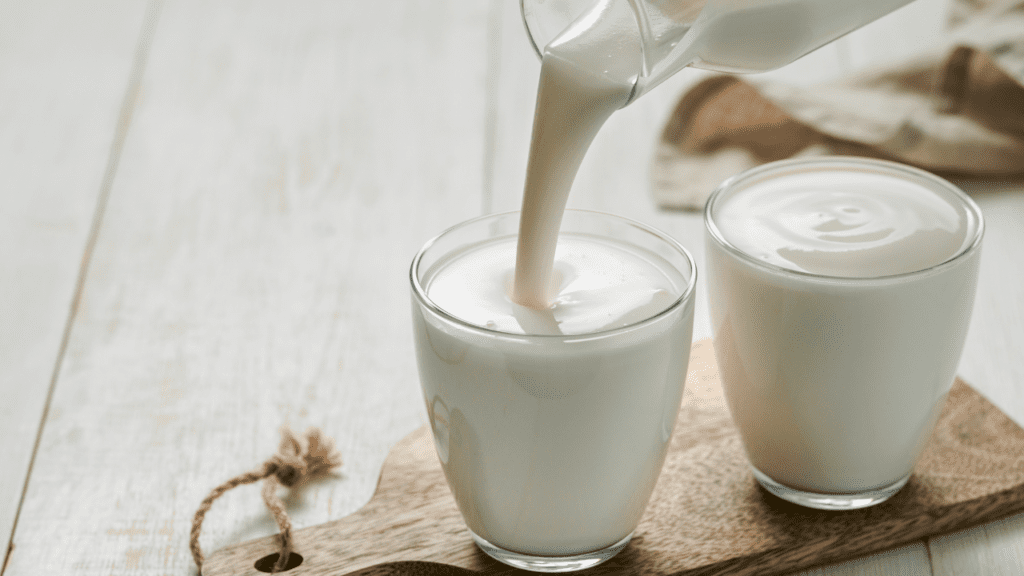
There are two main types of buttermilk: traditional buttermilk and cultured buttermilk. While they both add a tangy and unique flavor to dishes, they have some key differences.
Traditional Buttermilk: Traditional buttermilk is the liquid that remains after churning butter from cream. It was originally made from cream that was naturally separated from fresh milk and allowed to ferment over time. This process created a tangy and slightly sour liquid with a thinner consistency than cultured buttermilk. Traditional buttermilk can be further classified into two types:
- Sour Cream Buttermilk: This traditional buttermilk is made from the liquid left over after churning cultured cream into butter. It has a distinct sour taste and is often used in baking or as a base for salad dressings.
- Sweet Cream Buttermilk: Sweet cream buttermilk is made from the liquid that remains after churning fresh cream into butter. It has a slightly sweeter flavor than sour cream buttermilk and is commonly used in baking recipes.
Cultured Buttermilk: Cultured buttermilk, on the other hand, is the type of buttermilk commonly found in stores and used in recipes. It is made by fermenting milk with active bacteria cultures. This fermentation process thickens the buttermilk and adds depth of flavor, tanginess, and a creamy texture. Cultured buttermilk is often used in baking to create moist and tender baked goods, and it is a key ingredient in favorites like buttermilk pancakes and buttermilk biscuits.
While traditional and cultured buttermilk have unique qualities, they can be used interchangeably in most recipes. The two choices depend on personal preference and the dish’s desired flavor profile.
Storing and Shelf Life of Buttermilk
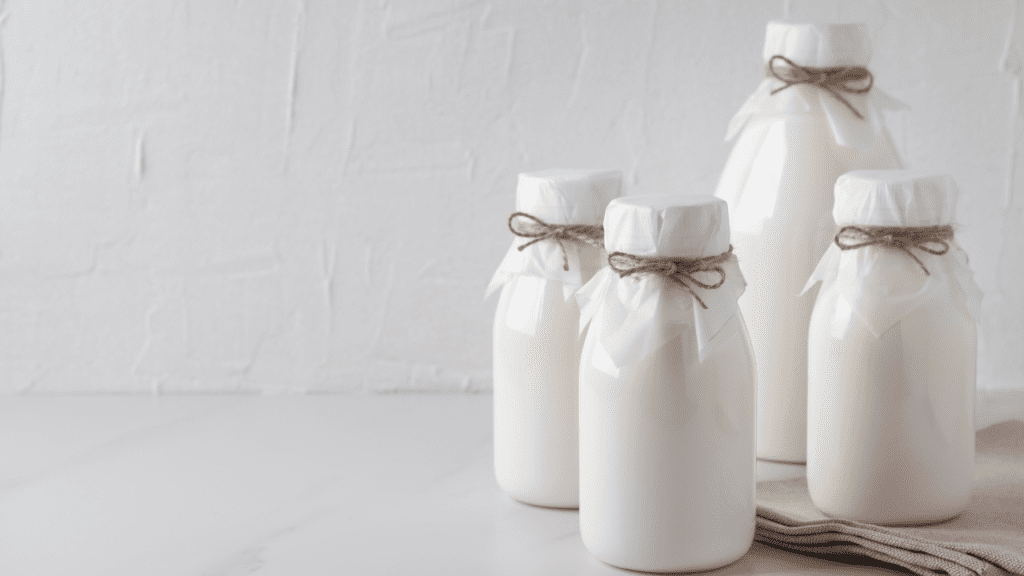
To maintain the freshness of buttermilk, it is crucial to store it properly. Follow these guidelines to ensure your buttermilk stays fresh:
- Store buttermilk in the refrigerator at a temperature below 40°F (4°C) to slow down potential bacterial growth.
- Keep the buttermilk container tightly sealed to prevent air and moisture from entering, which can cause spoilage.
- Cultured buttermilk can last 1 to 2 weeks beyond the carton date in the refrigerator if stored properly.
- If you won’t be using the entire carton of buttermilk within that time frame, consider freezing it for longer storage.
When freezing buttermilk:
- Pour the buttermilk into a freezer-safe container, leaving some headspace to allow for expansion.
- Seal the container tightly to prevent freezer burn and odors from entering.
- Label the container with the freezing date to keep track of its shelf life.
- Buttermilk can be frozen for up to 3 months.
- When thawing frozen buttermilk, knead the bag gently to ensure the consistency is well-mixed, as separation may occur.
If your buttermilk smells spoiled or shows visible signs of mold, discard it. Consuming spoiled buttermilk can lead to foodborne illnesses.
Remember, proper storage is essential for maintaining the quality and taste of buttermilk, so make sure to follow these guidelines to enjoy fresh buttermilk in your recipes.
Varieties of Buttermilk around the World

Buttermilk is popular in American cuisine and has variations in different parts of the world. Let’s explore some of the unique types of buttermilk found in various cultures:
1) Indian Chaas and Lassi
In India, buttermilk is known as chaas or Lassi. Chaas is a refreshing yogurt-based drink made by diluting yogurt with water and adding spices like cumin or mint. On the other hand, Lassi is a sweet or savory yogurt-based drink that can be enjoyed plain or with added fruits or flavors.
| Indian Buttermilk Varieties | Description |
|---|---|
| Chaas | A spiced buttermilk drink made by diluting yogurt with water and adding spices like cumin or mint. |
| Lassi | A sweet or savory yogurt-based drink that can be enjoyed plain or with added fruits or flavors. |
2) Irish Buttermilk in Traditional Soda Bread
In Ireland, buttermilk plays a crucial role in traditional soda bread recipes. The acidity of buttermilk reacts with baking soda to create a leavening effect and provide a distinctive tangy flavor to the bread.
| Irish Buttermilk Usage | Description |
|---|---|
| Soda Bread | Buttermilk is commonly used in traditional Irish soda bread recipes to enhance the flavor and react with baking soda to leaven the bread. |
These are just a few examples of how buttermilk is utilized in different cultures. It showcases the versatility and adaptability of this beloved ingredient in various culinary traditions.
Delicious Buttermilk Recipes to Try

Buttermilk is not just a versatile ingredient; it’s also the secret to creating mouthwatering dishes with your taste buds singing. Whether craving something sweet or savory, buttermilk adds a tangy and creamy element that takes your recipes to the next level. Here are some delectable buttermilk recipes to satisfy your cravings:
1) Buttermilk Pancakes
Start your day off right with fluffy and tender buttermilk pancakes. The acidity of buttermilk reacts with the leavening agents, resulting in a light and airy texture. Serve these golden beauties with your favorite toppings, like maple syrup, berries, or a dollop of whipped cream. They are sure to become a breakfast favorite in your household.
2) Buttermilk Biscuits
No Southern-style meal is complete without a basket of buttermilk biscuits. These buttery and flaky treats are perfect for fried chicken, sausage gravy, or even as a standalone snack. The tanginess of buttermilk adds a delightful contrast to the biscuits’ richness, making them utterly irresistible.
3) Buttermilk Fried Chicken
Take your fried chicken game to new heights with a buttermilk marinade. Soaking the chicken pieces in a mixture of buttermilk and spices adds flavor and helps tenderize the meat. The result? Golden and crispy fried chicken that’s juicy and succulent on the inside. Serve it alongside some homemade coleslaw for a classic Southern feast.
4) Buttermilk Ranch Dressing
Why settle for store-bought ranch dressing when you can easily whip up a creamy and tangy homemade version? Buttermilk is the star ingredient in this dressing, adding a refreshing zing that perfectly complements crisp garden salads, buffalo wings, and even as a dip for fresh veggies. Once you try homemade buttermilk ranch, you’ll never return to the bottled stuff.
5) Buttermilk Pie
If you have a sweet tooth, buttermilk pie is a must-try dessert. This classic Southern treat features a silky custard with a subtle tanginess that pairs beautifully with a flaky pie crust. The smooth and creamy texture of the filling, combined with the delicate sweetness, makes each bite pure bliss. Dust it with powdered sugar and serve it with a dollop of whipped cream for the ultimate indulgence.
6) Buttermilk Cake
Buttermilk adds incredible moisture and tenderness to cakes, making it an excellent choice for various cake recipes. The possibilities are endless, from classic buttermilk vanilla cake to rich chocolate buttermilk cake. Top it with your favorite frosting, whether tangy cream cheese frosting or smooth buttercream. Every slice of buttermilk cake is guaranteed to be a crowd-pleaser.
| Recipe | Key Ingredients |
|---|---|
| Buttermilk Pancakes | Flour, buttermilk, eggs, baking powder, sugar, butter |
| Buttermilk Biscuits | Flour, buttermilk, butter, baking powder, baking soda |
| Buttermilk Fried Chicken | Chicken pieces, buttermilk, flour, spices |
| Buttermilk Ranch Dressing | Buttermilk, mayonnaise, garlic, herbs, lemon juice |
| Buttermilk Pie | Eggs, sugar, buttermilk, flour, butter, vanilla extract |
| Buttermilk Cake | Flour, buttermilk, sugar, butter, eggs, baking powder, vanilla extract |
These are just a few of the incredible buttermilk recipes you can try. Whether you’re a seasoned chef or a beginner in the kitchen, buttermilk is your secret weapon for creating delicious and memorable dishes that will leave everyone asking for seconds.
Conclusion

Buttermilk is a versatile ingredient that adds depth and complexity to various recipes. Whether you use it as a tenderizer, a leavening agent, or a flavor enhancer, buttermilk brings a tangy flavor and unique properties to your dishes.
One of the great things about buttermilk is its availability. You can easily find it in grocery stores or make it at home using simple ingredients. And if you ever find yourself without buttermilk, there are substitutes you can use to achieve similar results.
So why not try experimenting with buttermilk in your cooking? From pancakes and biscuits to fried chicken and salad dressings, there are endless possibilities to explore. Let buttermilk’s tangy and creamy nature take your recipes to the next level and delight your taste buds.
Thank you for reading! Be sure to check back soon for more informative and exciting articles.
Happy cooking!
FAQ

What is buttermilk?
Buttermilk is a versatile ingredient that is commonly used in cooking and baking. It is made by adding active bacteria cultures to milk and allowing it to ferment, resulting in a tangy and creamy liquid.
What are the culinary uses of buttermilk?
Buttermilk can be used in a wide variety of recipes. It is often used as a marinade to tenderize meats, as a leavening agent in baking, and as a key ingredient in salad dressings, soups, and sauces.
What are the benefits of buttermilk?
Buttermilk is low in fat and calories, high in protein, and rich in calcium, vitamin B12, and potassium. It is also more easily digestible for those with lactose intolerance and can promote a healthy gut.
How can I make a homemade buttermilk substitute?
Mix an acid like lemon juice or vinegar with milk to make a homemade buttermilk substitute. Another option is to use full-fat yogurt as a 1-to-1 replacement for buttermilk.
How do I make buttermilk from milk?
To make buttermilk from milk, add a buttermilk starter culture to milk and allow it to ferment for 12 to 24 hours. Another method is to mix store-bought buttermilk with milk and let it ferment until thickened.
What is the difference between traditional buttermilk and cultured buttermilk?
Traditional buttermilk is the liquid left after churning butter from cream, while cultured buttermilk is made by fermenting milk with active bacteria cultures. Cultured buttermilk is more commonly found in stores and used in recipes.
How should buttermilk be stored, and what is its shelf life?
Buttermilk should be stored in the refrigerator to maintain its freshness. Cultured buttermilk can last 1 to 2 weeks beyond the carton date in the refrigerator and can be frozen for up to 3 months.
Are there different varieties of buttermilk around the world?
Yes, there are different variations of buttermilk in different cultures. For example, in India, buttermilk, chaas, or Lassi is a popular refreshing drink made by diluting yogurt with water and adding spices.
What are some delicious buttermilk recipes to try?
Some popular buttermilk recipes include pancakes, biscuits, fried chicken, ranch dressing, pie, and cake.
Can you summarise what we’ve learned about buttermilk?
Buttermilk is a versatile ingredient that can be used in many recipes. It offers several nutritional benefits and can be made at home or purchased from the store. Buttermilk can be substituted with acid and milk or full-fat yogurt. It has a tangy flavor and unique properties that enhance the taste and texture of dishes.
Source Links
- https://www.thepioneerwoman.com/food-cooking/cooking-tips-tutorials/a101038/buttermilk-101/
- https://www.countryliving.com/food-drinks/a30273717/what-is-buttermilk/
- https://www.ambitiouskitchen.com/how-to-make-homemade-buttermilk/
Hey There! Some links on this page are affiliate links, which means that as an Amazon Associate, I may earn a small commission at no extra cost to you. I greatly appreciate your support! Learn more on my Affiliate Disclosure page.



